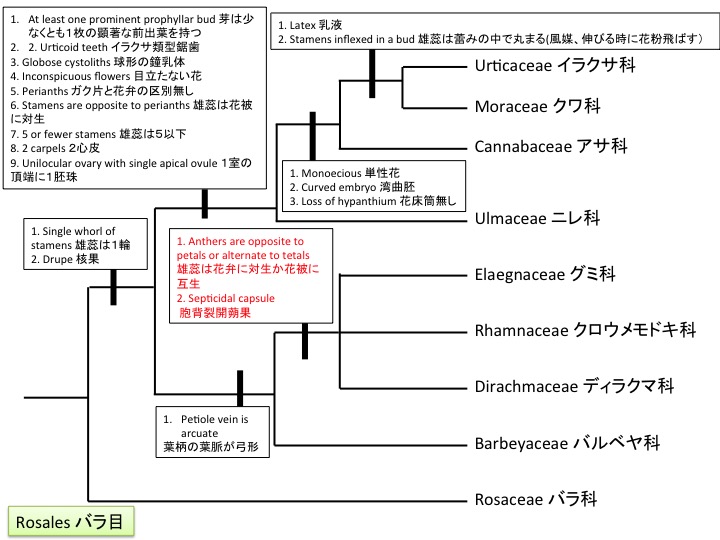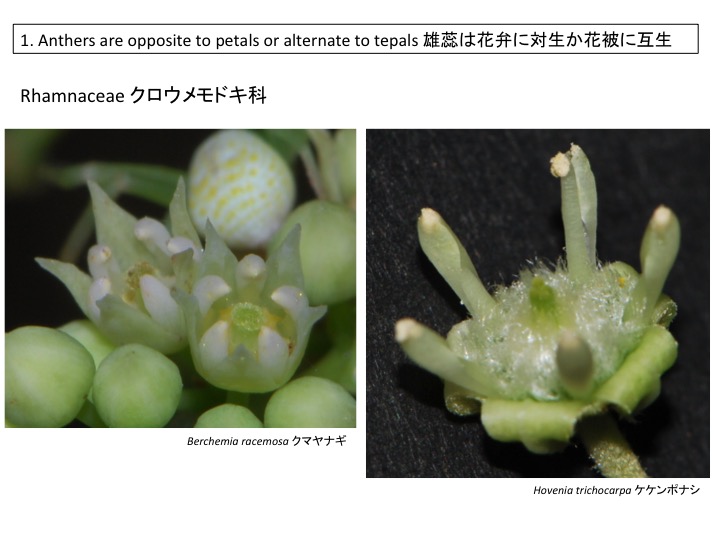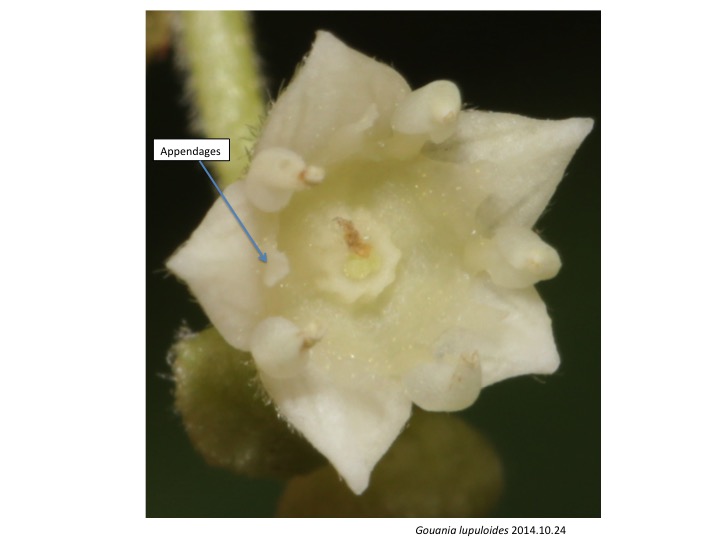「雄蕊は花弁に対生か花被に互生」はディラクマ科、グミ科、クロウメモドキ科をまとめる共有派生形質である。しかし、雄蕊と花弁が対生の位置に来ることはVitaceaeとCornaceaeに見られる以外は被子植物でほとんど無く(Richardson et al. 2000)、ディラクマ科、グミ科、クロウメモドキ科の共通祖先で何がおこったのだろうか。一つは、花弁と雄蕊の配列が互生から対生に変化するような発生上の変化が起こった可能性である。原基の配置は主にオーキシンによって制御されており(総説としてBartlett and Thompson 2014)、その制御機構に変化が起こった可能性がある。
“Anthers are opposite to petals or alternate to tepals” is a synapomorphic character circumscribing the Dirachmaceae, Elaegnaceae, and Rhamnaceae, However, opposite arrangement of petals and stamens is unusual in angiosperms and only observed in the Vitaceae and Cornaceae (Richardson et al. 2000). How did such unusual arrangement evolve in the lineage. One of possibilities is that developmental program for the organ formation was changed. Arrangement of lateral organ primordia is mainly regulated by auxin (reviewed in Bartlett and Thompson 2014) and the regulation may be changed.
Bartlett, M.E., and Thompson, B. (2014). Meristem identity and phyllotaxis in inflorescence development. Frontiers in plant science 5, 508.
Richardson, J.E., Fay, M.F., Cronk, Q.C.B. and Chase, M.W. 2000. A revision of the tribal classificaiton of Rhamnaceae. Kew Bull. 55: 311-340.
第二の可能性は、花弁と雄蕊の間に花弁に互生する雄蕊がもう1輪あったが、それが退化した可能性である。Gouania属は雄蕊の間に突起が形成される。この突起が退化した雄蕊だとすると、雄蕊が2輪形成され、クロウメモドキ科の他の種では外側の雄蕊が退化して内側の雄蕊のみ残っているのだとすると、うまく花弁と対生することになる。詳細な発生過程を調べればはっきりするだろう。
The second possibility is that another whole of stamens, which is alternate to petals is reduced. Gouania forms appendages that looks like reduced stamen between functional stamens. If these appendages are reduced stamen, there are two wholes of stamens and stamens formed in the inner whole should be covered by petals.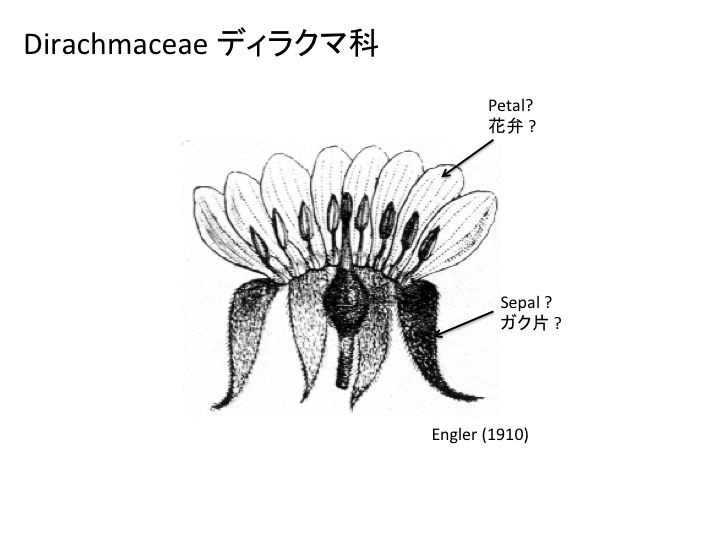
第三の可能性は、花弁に見えるのは雄蕊の付属器官である可能性である。クロウメモドキ科の姉妹群であるディラクマ科のDirachma socotranaの花弁と雄蕊の基部は癒合している(Bayer 2004)。発生過程の観察は無いが、花弁状の器官は雄蕊の付属器官として発生してくる可能性もある。
The third possibility is that petals are appendages of stamens. The longitudinal section of Dirachma socotrana (Bayer 2004) in the Dirachmaceae sister to the Rhamnaceae shows that a petal and a stamen are merged at the base. It is possible to interpret that the D. socotrana petal is an appendage of the stamen.
Bayer, C. 2004. Dirachmaceae. In Families and Genera of Vascular Plants. VI Flowering plants, Dicotyledons, Celastrales, Oxalidales, Rosales, Cornales, Ericales. Ed. K. Kubitzki. 122-124. Fig. 42B
Engler, A. 1910. Die Vegetation der Erde, Sammlung pflanzengeographischer Monographien, v. 9 Bd. I, Heft 1. Fig. 186.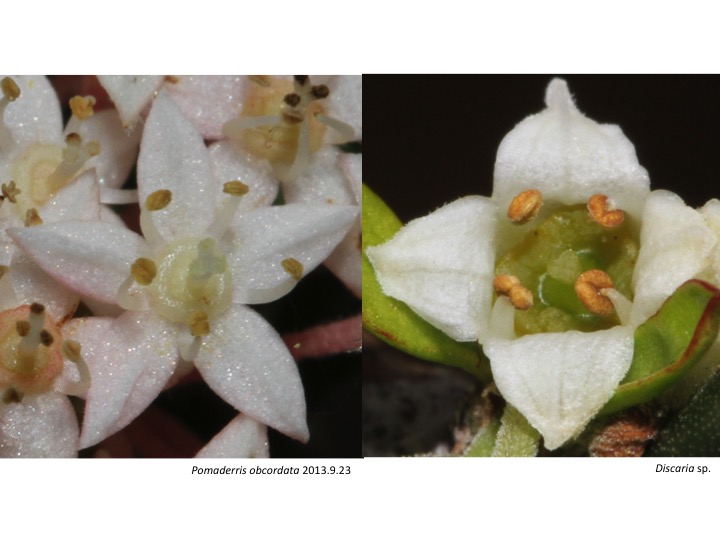
クロウメモドキ科のいくつかの種では花被が1輪で花弁状となり、雄蕊と互生している。
In some species in the Rhamnaceae, a single whole of tepals are formed and tepals are alternate to stamens.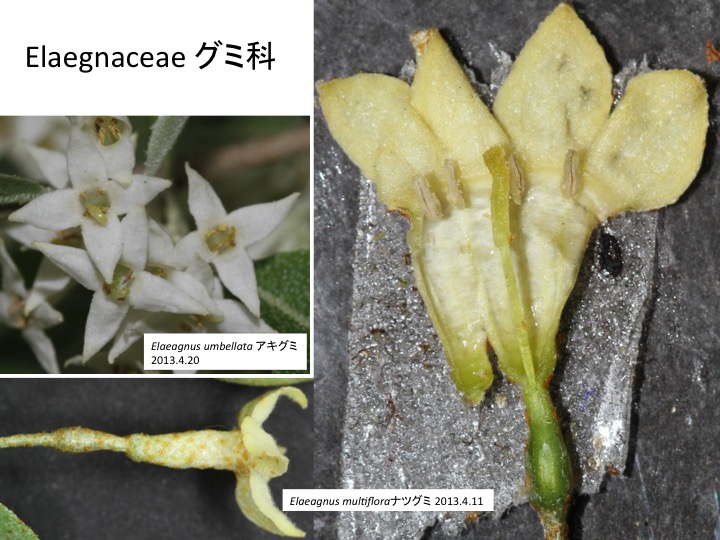
グミ科の種は1輪の花被を持ち、雄蕊は花被に互生する。
Flowers of Elaegnaceae species form a whole of tepals and stamens are alternate to tepals.

